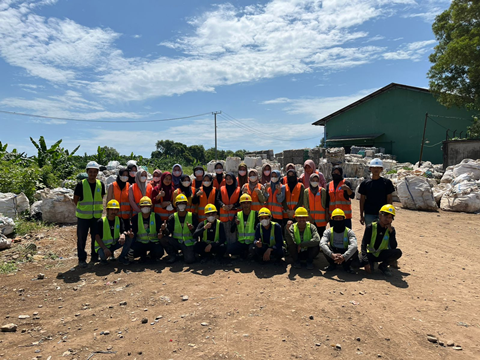
Prevented Ocean Plastic has opened its seventh high-capacity waste plastic collection centre in Makassar, Indonesia; it expects to process 500 tonnes of recycled plastic every month and keep waste out of the ocean.
According to the World Economic Forum, at least 8 million tonnes of plastics leak into the ocean every year. This is considered the equivalent of dumping a garbage truck into the ocean every minute.
Makassar is thought to be especially vulnerable to plastic pollution as it is located in Sulawesi, an island province that is difficult to access logistically. A new collection centre is hoped to make way for efficient waste management infrastructure and tackle the rise in waste polluting the region.
Furthermore, it is anticipated to provide opportunities for reliable income in dignified working conditions, opening up 50 jobs for local people. It is also set to distribute certified, traceable, ‘premium quality’ recycled plastic to global markets.
Prevented Ocean Plastic claims that each of its new centres adheres to the Prevented Ocean Plastic Standards. These were created in line with the Ethical Trading Initiative (ETI) base code and follow ISEAL’s Code of Good Practice, alongside Bantam Materials UK’s Good Manufacturing Practices and traceability process.
The U.S. Agency for International Development (USAID) provided funding for the centre via its Clean Cities Blue Ocean initiative. It follows the model of Prevented Ocean Plastic’s collection centre in Semarang, Indonesia, which was also funded by USAID.
The Prevented Ocean Plastic model intends to facilitate a ‘just transition for the recycling industry’ and align with the United Nations’ 2030 Agenda for Sustainable Development – establishing a ‘fair, just, and inclusive’ circular economy for plastics. The model is designed for scalability and repeatability in order to protect the earth’s oceans and marine life.
“Indonesia is a country of 17,000 islands and no drinkable water from the tap,” explains Prevented Ocean Plastic director Raffi Schieir. “Along with other factors, this contributes to the country being ranked the number two source for ocean plastic pollution.
“With USAID’s support, we are hoping to address some of the logistical obstacles of the region and help clean up the environment. Makassar is the second centre we have opened with the support of USAID in Indonesia, working together to create brick and mortar infrastructure to support informal plastic collection in the region for substantial impact.”
Clare Romanik, USAID’s lead Ocean Plastics and Urban advisor, continued: “USAID is proud to partner with Prevented Ocean Plastic Southeast Asia to build an inclusive circular economy across Indonesia. This partnership demonstrates the power of blended finance as a model to scale solutions to the plastic crisis.”
Last year, Prevented Ocean Plastic revealed its plans to open 25 high-volume collection centres across various global regions by 2025. This ’25 by 2025’ mission seeks to turn ‘ocean-bound’ plastic waste into fully traceable plastic material at a potential capacity of 45,000 tonnes.
Since the announcement, Prevented Ocean Plastic claims to have added 20,000 tonnes of plastic waste collection capacity per year through its new builds; and created 200 jobs for local communities, including 20 in higher-level office jobs, 20 in management and coordination, and over 160 in collection and sortation.
In a similar development, Greiner Packaging and Plastic Bank have extended their partnership to collect plastic waste from coastal areas in the Philippines. It is reported that they have already eliminated over 610 tons of plastic, with local collectors encouraged to swap plastic waste for incremental income and access to work, health insurance, meal vouchers, school supplies, and more.
On the other hand, a study published in Nature Geoscience argues that there are fewer microplastics in the ocean than previously suggested, with a denser layer of pollution present on the surface than beneath the waves. However, these larger plastic fragments are feared to remain for decades.
If you liked this story, you might also enjoy:
How are the top brands progressing on packaging sustainability?
The ultimate guide to global plastic sustainability regulation












No comments yet